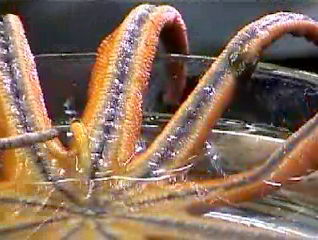Physical description:
The Arctonoe vittata (formerly known as Halosydna lordi) usually have around 25 or more pairs of scale, which they sometimes shed when they are disturbed. Arctonoe grows up to 8cm to 10 cm long and is usually light yellow. However the color may change depending on its host. Scientists do not know wether this is due to a certain compound on the host that changes their color, or wether it is because they basically eat the same thing, but the scale worm usually very lightly changes its color according to its host.
Distribution in the world: Scale worms live in the North Pacific ocean. It is one of the most studied worms and it has been mostly studied near the coasts of Japan and also near Kamtchaka, far east Russia. It also lives in the north west coast of North America, including the coast of British Columbia. It lives mostly in salt water and almost never in fresh water.
Biotic Associations: The Arctonoe vittata a commensal worm, lives on other species. It observes a positive relationship with its host, notably the starfish Asterias amurensis or the mollusc keyhole limpet Diadora aspera It usually lives near the oral part of its host, and when there are two A.vittata there, the other one will live on the arm if it is living on a starfish. The length of the worm is big considering the size of its host, sometimes its ends almost touch when it is curled up on the oral orifice. It mostly likes to live on larger hosts because they are older and more exposed to plankton. If the A.vittata is living on the keyhole limpet, and the keyhole gets attacked by a starfish, the worm will sense that the demise of its host will lead to its own demise. Thus it will bite the seastar’s tube feet and cause it to withdraw. The scale worm is attracted to chemicals released by it’s host. It is interesting to note that the host is also attracted by chemicals released by the commensal worm. The commensal worms seemed to have a different taste for their host depending on which part of the world they came from. However, the limpet Acmaea pallida was the overall favorite host.
Interesting local behavior: Some scale worms have been spotted on seastars. They were colored white, the same as the underside of the star. There have also been some scale worms spotted on sea cucumbers, they were of a reddish color, and were the Red commensal scale worm Arctonoe pulchra
Reproduction and feeding: The A.vittata bites off the food that is left over from the side of the mouth of its host. They are usually fatter if they are located near the mouth of the host. The worms are hermaphrodites. The worm will leave eggs on its host, some grow there, usually the first ones. The rest will move to a different host because there is too much competition with the one that is already there.
| Domain | Eukarya |
| Kingdom | Animalia |
| Phylum | Annelida |
| Class | Polychaeta |
| Order | polychaetes |
| Family | polynoidae |
| Genus | Arctonoe |
| Species | vittata |
 The Race Rocks taxonomy is a collaborative venture originally started with the Biology and Environmental Systems students of Lester Pearson College UWC. It now also has contributions added by Faculty, Staff, Volunteers and Observers on the remote control webcams. Oct 2003, Lindsay Cheong The Race Rocks taxonomy is a collaborative venture originally started with the Biology and Environmental Systems students of Lester Pearson College UWC. It now also has contributions added by Faculty, Staff, Volunteers and Observers on the remote control webcams. Oct 2003, Lindsay Cheong
with underwater photography of Ryan Murphy |
